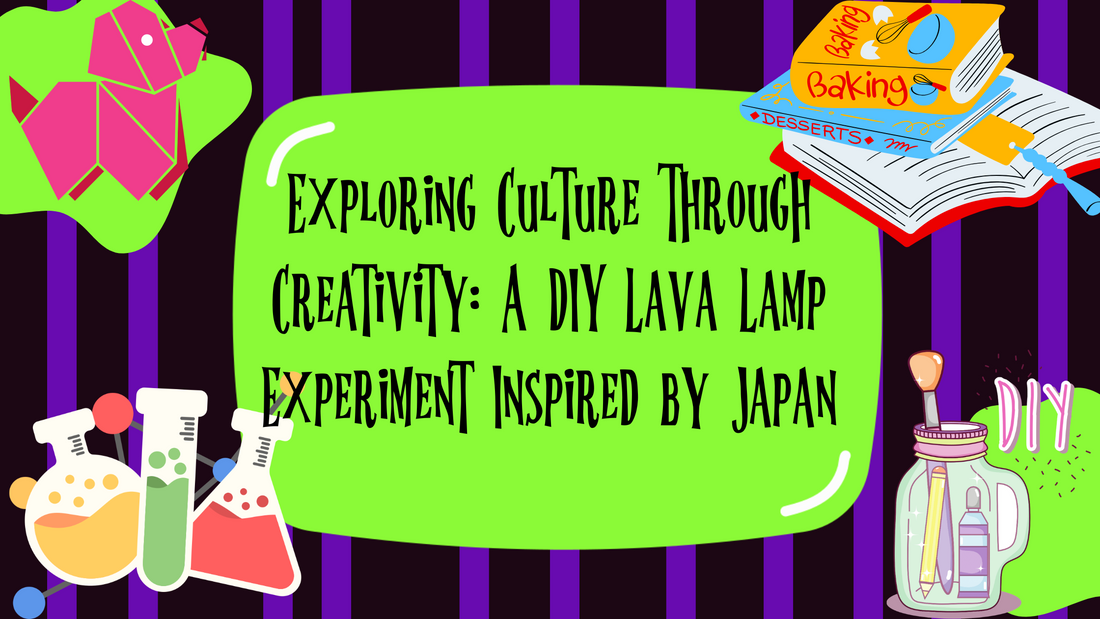As an affiliate, I earn from qualifying purchases, but this doesn't affect the reviews or recommendations—your trust is important to me!
Exploring : Uncover the Secret: DIY Lava Lamp Experiment at Home

Today, We're Making:
- - DIY Lava Lamp Experiment
- - Time Capsule History Project: On the special date (08-07-2025), ask the kids to collect important personal or international news items, photos and objects related to science, technology, engineering.
Ready for a fun-packed family adventure right in the comfort of your home?
Stir up some creativity and fun with a unique DIY Lava Lamp Experiment that will illuminate your at-home learning while etching unforgettable smiles on your little ones' faces! Sparking both excitement and curiosity, this interactive experiment offers a brilliant fusion of craft and simple science, perfect for keeping those hands busy, brains active, and eyes wide in amazement.
This easy DIY project isn't just about creating a captivating lava lamp—it’s about bringing home the allure of science, moulding innovative minds, and discovering the wonders hidden in everyday substances. So, ready to delve into the intriguing world of DIY Science Magic and uncover the enchanting secret of the homemade lava lamp? Let's get started on this spectacular journey!
Budding Scientists Step Right Up: Mastering the DIY Lava Lamp
First and foremost, a DIY Lava Lamp experiment is not a daunting task - it's a playground for budding scientists or simply anyone intrigued by the magic woven into everyday phenomena. The beauty of this DIY home experiment lies in its simplicity and the accessible ingredients. For your magical voyage into science, you will need just a few commonplace items:
- A transparent glass or container
- Water
- Vegetable oil
- Food coloring
- Alka Seltzer tablets
Crafty kids, as well as adults, will love the thrill of creating something so mesmerizing with items easily found in their very own kitchen. Surely, this hands-on interactive experiment is quite the joy of learning through play!
Embracing the Wonder of DIY Science Magic
Once you have your items ready, it's time for the action to begin! First, you fill one-third of your container with water. Next comes the oil. Pour it until your container is nearly full. Here's where you and the kids will witness the first part of your DIY science magic: oil and water are like rival siblings; they just don't mix!
Following this, pick the colour of your soon-to-be lava and drop in the food colouring. It directly sinks through the oil, blending with the water below. But hold onto the edge of your seats, for the real DIY Lava Lamp experience is yet to ignite!
The Grand Finale: The Homemade Lava Lamp Secret Revealed
Crush an Alka Seltzer tablet and sprinkle it into the mix. Now, sit back and watch the sizzling magic unfold right before your eyes. Like a mythical creature awakening, your homemade lava lamp comes alive! The Alka Seltzer reacts with water, forming gas bubbles which fight gravity to rise through the oil, carrying some coloured water with them. On reaching the surface, the gas escapes, and the coloured water falls back. This simple home science concept illuminates the show that is your DIY Lava Lamp experiment.
Engaging, educational, and entertaining, this DIY science experiment is a perfect easy DIY for kids and adults alike. It illustrates the fundamentals of scientific concepts like density and solubility in a captivating display that will, without doubt, illuminate your at-home learning experience.
This DIY project is not merely about crafting a handmade lava lamp. It's a journey filled with discovery and wonder, allowing children and adults to experience the joy of simple science. A fascinating, budget-friendly experiment that delivers massive smiles, and promotions to little scientists!

End of Our DIY Lava Lamp Journey
And so we've reached the end of our DIY Lava Lamp journey. Embracing the simple wonder of science magic right in our homes, we've not just created a captivating lamp, but also lit the flame of curiosity and understanding, sparking countless wide-eyed moments of pure joy.
This experiment underlines the fact that science is not just confined to labs and textbooks but is a colorful tapestry woven into our daily life, offering fascinating secrets to those willing to dig deeper. Keep the spirit of exploration alive, and remember, the magic truly begins when science meets creativity.
So, don a lab coat, arm yourselves with everyday kitchen supplies and get ready for your next exciting DIY science adventure. Until then, keep shining, keep learning, keep exploring!

You May Also Like These:
Time Capsule History Project
Date: August 7, 2025Ingredients:
- A sturdy container or box that can withstand years of storage.
- Paper to document personal ideas, current events, and messages for the future.
- Personal items: These can be photos, favorite small toys, coins, or any other small memento that will be meaningful to look back on.
- Sealants like wax or tape to ensure the time capsule is airtight and secure.
Instructions:
- Gather all ingredients: Ensure you've got all your materials ready to start creating your time capsule.
- Brainstorm and document: Sit with the kids and jot down some current events, personal dreams, wishes, or any messages for the future you'd like to add.
- Choose personal items: Include small mementos that would be interesting to look back on. These can be personal or events-related items.
- Place all items in the container: Now it's time to organize and place all these special items in the box or container you've chosen.
- Seal the time capsule: Use wax or tape to seal the box to preserve the contents and prevent it from damage or opening.
- Store it away: Find a safe, secure place to store your time capsule where it will remain undisturbed until the determined date or year.
Creating a time capsule is a fun and educational STEM project that can be enjoyed by the whole family. Take your time selecting which items you'd like to include, making sure they will withstand the test of time. Have fun!
STEM Project 1: DIY Magnifying Glass
Ingredients:- Paper
- Pencil
- Plastic bag
- Water
- Trace the outline of the base of a water glass onto a piece of paper and cut it out.
- Place the round piece of paper into a plastic bag and seal the bag tightly.
- Pour water into the bag until the paper is fully submerged.
- Look through the bag at various objects - notice how they appear larger!
STEM Project 2: DIY Solar System
Ingredients:- Spheres of different sizes (e.g. balls, beads)
- Paint
- Wire or string
- Large piece of cardboard or poster
- Paint each sphere to resemble a planet in our Solar System.
- Once dry, arrange them in order on the cardboard or poster according to their distance from the sun.
- Attach each planet with wire or string to create a hanging mobile Solar System.
STEM Project 3: DIY Volcano
Ingredients:- A jar
- Sand or clay
- Vinegar
- Baking soda
- Red food coloring
- Arrange the clay or sand around the jar to form a volcano.
- Pour the baking soda into the jar followed by a few drops of red food coloring.
- Add vinegar to the jar and watch as your volcano erupts with 'lava'.
Create a Solar System Model
Ingredients:- Spray Paint
- Styrofoam Balls of Different Sizes
- Dowel Rods or Straws
- Clay or Play Dough
- String or Wire
- Glue
- Take your styrofoam balls and spray paint them to correspond with the planets in our solar system.
- Allow the paint to dry completely.
- Once the painted balls are dry, attach them along the dowel rods or straws.
- Use clay or play dough to secure them in place.
- Attach strings or wires to hang your solar system model, apply glue to secure them properly.
- Let's hang our model, you've just created a solar system model at home!
Create a Volcano Model
Ingredients:- A large piece of Cardboard
- Vinegar
- Red Food Coloring
- Baking Soda
- Plastic Bottle
- Modeling Clay or Play Dough
- Place the plastic bottle in the middle of the cardboard and begin to build up the shape of the volcano using the modeling clay or play dough, leaving the top of the bottle uncovered.
- Allow the clay to dry completely.
- Mix a few drops of red food coloring with vinegar.
- Fill the bottle halfway with baking soda.
- Pour the vinegar into the bottle, stand back and watch your volcano model erupt!
STEM Project: Building a DIY Smartphone Projector
Ingredients:
Please ensure to gather all of the following items before commencing this project:
- Shoe box
- Paper clip
- Magnifying glass (best if it is 3-4 inches in diameter)
- Scotch tape
- Craft knife
- Smartphone
Instructions:
Step 1: Prepare the Box
Use a craft knife to cut a hole on one side of the shoe box. The hole should be slightly smaller than the size of your magnifying glass.
Step 2: Attach the Magnifying Glass
Insert the magnifying glass in the hole made in the shoe box and secure it with the scotch tape. The curved side should be facing the inside of the box.
Step 3: Phone Placement
Use a paper clip to make a stand for the smartphone. Place the stand towards the other side of the box. The smartphone should be facing the magnifying glass and the screen should be in line with the center of the magnifying glass.
Step 4: Testing
Switch on your smartphone's screen and play a video to test the projector. You may need to adjust the distance between the phone and the magnifying glass to better focus the projection.
Remember: The video on your smartphone should be played upside down because the magnifying glass will flip the image.
STEM Project: Building a Balloon-Powered Car
Objective:
To build a balloon-powered car and understand the concept of thrust.
Materials Needed:
- 1 Balloon
- 1 Straw
- 4 Bottle caps
- 1 Small, lightweight plastic or cardboard piece
- Tape
Instructions:
- Assemble the Wheels: Tape the bottle caps onto the corners of your lightweight plastic or cardboard piece. These will serve as the wheels of your car.
- Attach the Straw: Cut the straw to match the length of your car (plastic or cardboard piece). Tape it to the top.
- Insert the Balloon: Put one end of the balloon into the straw and secure it with tape, making sure to have a good air seal.
- Test Your Car: Blow up the balloon through the straw, then place your car on a smooth flat surface and let go! The release of the air from the balloon will propel your car forward.



























